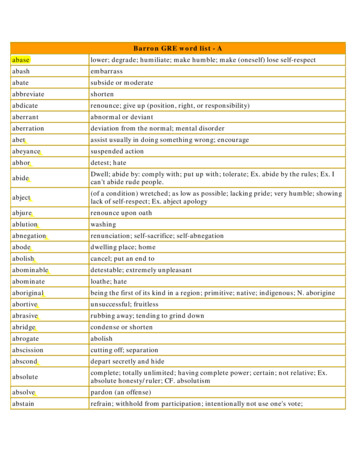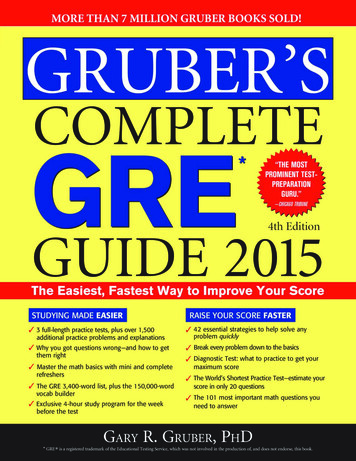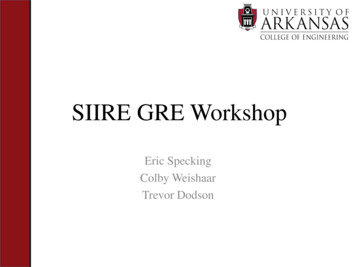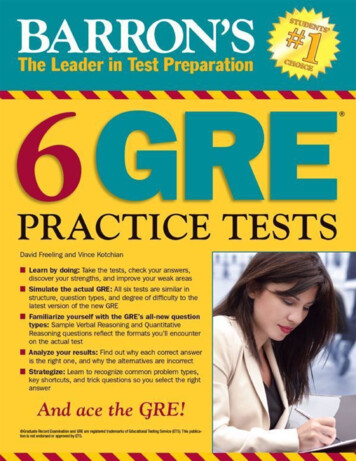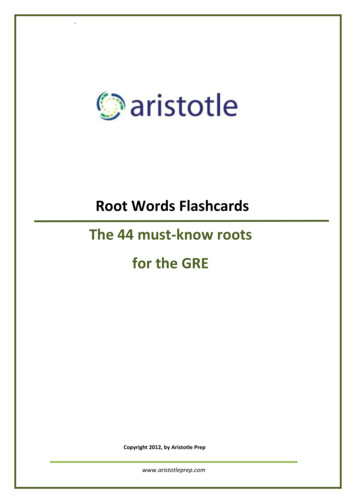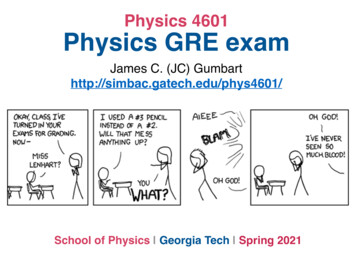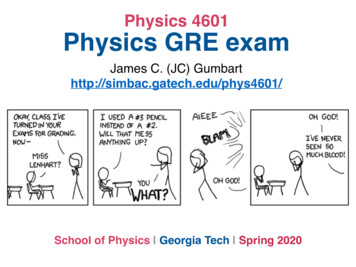
Transcription
GRE EXAMMath WorkbookSeventh Edition
Table of ContentsU pdates to the GREHow to U se This BookPART ONE: GETTING STARTEDChapter 1 Introduction to GRE MathPART TWO: MATH CONTENT REVIEWChapter 2 ArithmeticChapter 3 AlgebraChapter 4 GeometryPART THREE: QU ESTION TYPE REVIEWChapter 5 Quantitative ComparisonsChapter 6 Word ProblemsChapter 7 Data InterpretationsA Note for International StudentsOther Kaplan Titles on Graduate School Admissions
Updates to the GREInstead of one major overhaul as originally planned, ETS will introduce revisions to the GRE gradually, beginning with twonew question types-one math, one verbal-that were introduced into the computer-based GRE in November 2007. On TestDay, you may see just one sample of the new math question type, just one sample of the new verbal question type, OR youwon’t see either question at all. For the time being, these new question types do not count toward your score. As of thisprinting, ETS has not announced a timeline for when these new types will count toward your score.NEW QU ANTITATIVE QU ESTION TYPE-NU MERIC ENTRYEssentially, the Numeric Entry question type does not provide any answer choices at all. None. Zip. Zero! You have to do themath, work out your answer and type it in the box provided. The most important thing to keep in mind here is to readthrough the question very carefully; make sure you know exactly what’s being asked of you. Then check your work just ascarefully. Here’s a sample Numeric Entry question and answer explanation.The health club charges 35 per month plus 2.50 for each aerobic class attended. How many aerobic classes were attendedfor the month if the total monthly charge was 52.50?Click on the answer box, and then type in a number.U se backspace to erase.Answer: 7Translate the situation into an algebraic equation, and then solve for the unknown variable. We are asked to nd the numberof classes attended; assign the variable x to represent the number of aerobics classes attended. The monthly fee is 35, plus 2.50 for every class attended, or 2.5 times x (the number of classes).So the equation is 35 2.5x 52.50, where x equals the number of aerobic classes attended. Subtract 35 from both sides ofthe equation: 2.5x 17.5. Divide both sides by 2.5, and x 7STAY ON TOP OF THE LATEST DEVELOPMENTSAs ETS makes further announcements, you can depend on Kaplan to provide you with the most accurate, up-to-the-minuteinformation. You can get updates by visiting us at Kaptest.com/NEWGRE.Good Luck!
How To Use This BookKaplan has prepared students to take standardized tests for more than 50 years. Our team of researchers know more aboutpreparation for the GRE than anyone else, and you’ll nd their accumulated knowledge and experience throughout this book.The GRE is a standardized test, and so, every test covers the same content in roughly the same way. This is good news for you;it means that the best way to prepare is to focus on the sort of questions you are likely to see on Test Day. The main focus ofthis book is on strategic reviews, exercises, and practice tests with explanations that will help you brush up on any math skillsyou may have forgotten. If possible, work through this book a little at a time over the course of several weeks. There is a lotof math to absorb, and it’s hard to do it all at once.STEP 1: THE BASICSIn Part One of this book, “Getting Started,” we’ll provide you with background information on the quantitative section of thetest, what it covers, and how it’s organized.STEP 2: MATH CONTENT REVIEWOnce you have the big picture, focus on the content. Part Two of this book, “Math Content Review,” gives you a completetour of the math that you will see on Test Day. The material in the math content review is divided into particular subjects.Each subject begins with a review, followed by practice questions organized by level of di culty. This structure makes it easyfor you to pinpoint the math concepts you need to review and quickly get your skills up to speed.We suggest that you quickly skim the content review that introduces a section and then try the exercise. If you nd di cult,go back to the content review before moving on. If you do well on the exercise, try the basic problem set that follows it. Onceyou feel that you have a good grasp on the basics of this subject, try the intermediate and advanced problem sets. Answersand explanations for the practice problems appear at the end of the chapter. Read the explanations to all the questions-eventhose you got right. Often the explanations will contain strategies that show you how you could have gotten to the answermore quickly and efficiently.STEP 3: BECOME FAMILIAR WITH GRE QU ESTION TYPESThe GRE contains three main question types: Quantitative Comparisons, Word Problems, and Data Interpretation. Part Threeof this book covers these types with strategies and sample questions. Your focus here should be to familiarize yourself withthe question types so you won’t be trying to figure out how to approach them on Test Day.Now you’re ready to begin preparing for the math section of the GRE. Good luck!
PART ONE Getting Started
Chapter 1Introduction to GRE MathIf you’re considering applying to graduate school, then you’ve already seen all the math you need for the GRE—in juniorhigh. The only problem is, you may not have seen it lately. When was the last time you had to add a bunch of fractionswithout a calculator? The math that appears on the GRE is almost identical to the math tested on the SAT or ACT. You don’tneed to know trigonometry. You don’t need to know calculus.No matter how much your memories of junior high algebra classes have dimmed, don’t panic. The GRE tests a limitednumber of core math concepts in predictable ways. Certain topics come up in every test, and, chances are, these topics will beexpressed in much the same way; even some of the words and phrases appearing in the questions are predictable. Since thetest is so formulaic, we can show you the math you’re bound to encounter. Practice on test—like questions, such as those inthe following chapters, will prepare you for the questions you will see on the actual test.Here is a checklist of core math concepts you’ll need to know for the GRE. These concepts are vital, not only because they aretested directly on every GRE, but also because you need to know how to perform these simpler operations in order toperform more complicated tasks. For instance, you won’t be able to nd the volume of a cylinder if you can’t nd the area ofa circle. We know the math operations on the following list are pretty basic, but make sure you know how to do them.GREMATHBASICSAdd, subtract multiply and divide fractions. (Chapter 2)Convert fractions to decimals, and vice versa. (Chapter 2)Add, subtract multiply, and divide signed numbers. (Chapter 2)Plug numbers into algebraic expressions. (Chapter 3)Solve a simple algebraic equation. (Chapter 3)Find a percent using the percent formula. (Chapter 2)Find an average. (Chapter 2)Find the areas of rectangles, triangles, and circles. (Chapter 5)HOW MATH IS SCORED ON THE GREThe GRE will give you a scaled quantitative score from 200 to 800. (The average score is 575.) This score re ects yourperformance on the math portion of the GRE compared to all other GRE test takers.UNDERSTANDING THE QUANTITATIVE SECTIONIn the Quantitative section, you’ll have 45 minutes to complete 28 questions, which consist of three question types:Quantitative Comparisons, Word Problems, and Data Interpretation.The chart below shows how many questions you can expect of each question type, as well as the amount of time you shouldspend per question on each question type, very roughly speaking.Overview of the Quantitative Section Question TypesAs someone famous once said, “Know thine enemy.” You need to knowtogether if you want to take it apart.rsthand the way this section of the test is putWord ProblemsIn the Quantitative section on the GRE, you will have to solve problems that test a variety of mathematical concepts. WordProblems typically deal with core math concepts: percentages, simultaneous equations, symbolism, special triangles, multipleand oddball figures, combinations and permutations, standard deviation, mean, median, mode, range, and probability.You can expect about 10 Word Problems. As with other question types, the more questions you get right, the harder thequestions you will see.
Strategies, and sample questions can be found in Chapter 5.Quantitative ComparisonsOn Quantitative Comparisons, or QCs, as we like to call them, instead of solving for a particular value, your job is to comparetwo quantities. At rst, these questions tend to throw test—takers because of their unique format. But once you become usedto them, they should actually take less time to solve than other math question types.Doing well on QCs begins with understanding what makes them di erent from other math questions. The di culty of theQCs will depend on how well you are doing in the section. In each question, you’ll see two mathematical expressions. One isin Column A, the other in Column B. Your job is to compare them. Some questions include additional information about oneor both quantities. This information is centered, and is essential to making the comparison.Strategies and sample questions for QCs can be found in Chapter 6.Data InterpretationData Interpretation questions are statistics—oriented. You will likely be presented with a set of tables, charts, or graphs,which are followed by three to five questions.Strategies and sample questions can be found in Chapter 7.BACKDOOR STRATEGIESSometimes applying common sense or backdoor strategies will get you to the correct answer more quickly and easily. Thekey is to be open to creative approaches. Often this involves taking advantage of the question format. These three methodsare extremely useful when you don’t see—or would rather not use—the textbook approach to solving a question.Picking NumbersPicking numbers is a handy strategy for “abstract” problems—ones using variables either expressed or implied—rather thannumbers. An expressed variable appears in the question (“Jane had x apples and 3 oranges ”). Questions with impliedvariables describe a problem using just numbers, but the only way to solve the problem is by setting up an equation that usesvariables.Problems that lend themselves to the picking numbers strategy involve simple math, but the variables make the problemcomplex. They include those where both the question and the answer choices have variables, expressed or implied; where theproblem tests a number property you don’t recall; or where the problem and the answer choices deal with percents orfractions.Step 1. Pick Simple NumbersThese will stand in for the variables.Step 2. Try Them OutTry out all the answer choices using the numbers you picked, eliminating those that gave you a different result.Step 3. Try Different ValuesIf more than one answer choice works, use different values and start again.BacksolvingSome math problems don’t have variables that let you substitute picked numbers, or they require an unusually complexequation to nd the answer. In cases like these, try backsolving: Simply plug the given answer choices back into the questionuntil you nd the one that works. U nfortunately, there are no hard—and—fast rules that identify a picking numbers questionfrom a backsolving problem. You have to rely on two things: The experience you gain from answering practice questions, andyour instinct. Combining these two skills will point you to the fastest solution for answering a problem. If you do this usingthe system outlined below, it shouldn’t take long.Step 1. Estimate Whether the Answer Will Be Small or Large
Eyeball the question and predict whether the answer will be small or large. Your estimate needn’t (and shouldn’t) be precise;it just has to reflect your “feel” for the relative size of the answer.Step 2. Start with B or DFor small—quantity answers, start backsolving with answer choice B; for large—quantity answers, start with D. By startingwith B or D, you have a 40% chance of getting the correct answer in a single try because GRE answers are listed in order ofascending size. For example, if you start with B, you have these three possibilities: B is right, A is right (because B is too big),or B is too small.Step 3. Test the Choice That You Did Not Start WithIf B is too small or D is too large, you’ll have three choices left. In either case, testing the middle remaining choiceimmediately reveals the correct answer.EliminationHow quickly can you solve this problem?Jenny has 228 more marbles than Jack. If Bob gave each of them 133 marbles, she will have twice asmany marbles as Jack. How many marbles does Jenny have?If you know a bit about number properties, you can solve it without doing any calculations. If Jenny and Jack each had 133more marbles (an odd number), Jenny would have twice as many (an even number) as Jack. Since an even number minus anodd number is an odd number, Jenny must have an odd number of marbles. That allows us to eliminate B, C, and E. SinceJenny has 228 more marbles than Jack, you to eliminate A as well. Therefore, the correct answer has to be (D) and you didn’thave to do any math to get it!Elimination works on fewer problems than either picking numbers or backsolving. Where you can apply it, it’s very fast.When you can’t, the other two methods and even the straightforward math are good fallback strategies. You should useelimination if:the gap between the answer choices is wide and the problem is easy to estimate, oryou recognize the number property the test—maker is really testing.Number properties—the inherent relationships between numbers (odd/even, percent/whole, prime/composite)—are whatallow you to eliminate in correct answers in number—property problems without doing the math.For full examples of how these strategies work, pick up a copy of Kaplan’s GRE Exam Premier Program or GRE ExamComprehensive Program.MATH CONTENT ON THE GREArithmetic—About a third of all questions.Algebra—About a sixth of all questions.Geometry—About a third of all questions.Graphs—About a sixth of all questions.About a quarter of all questions are presented in the form of word problems.COMPUTER ADAPTIVE TESTING (CAT)The GRE CAT is a little different from the paper—and—pencil tests you have probably seen in the past.You choose answers on the GRE CAT by pointing and clicking with a mouse. You won’t use the keyboard in the math portionof the test. Each test is preceded by a short tutorial that will show you exactly how to use the mouse to indicate your answerand move through the test.
How a CAT Finds Your ScoreThese computer—based tests “adapt” to your performance. This means the questions get harder or easier depending onwhether you answer them correctly or not. Your score is not directly determined by how many questions you get right, but byhow hard the questions you get right are.When you start a section the computer:Assumes you have an average score.Gives you a medium—difficulty question.If you answer a question correctly:Your score goes up.You are given a harder question.If you answer a question incorrectly:Your score goes down.You are given an easier question.After a while you will reach a level where most of the questions will seem di cult to you. At this point you will get roughlyas many questions right as you get wrong. This is your scoring level. The computer uses your scoring level in calculating yourscaled score.Another consequence of the test’s adaptive nature is that for the bulk of the test you will be getting questions at the limit ofyour ability. While every question is equally important to your nal score, harder questions generate higher scores and easierquestions lower scores. You want to answer as many hard questions as possible. This is a reason to concentrate your energieson the early questions. Get these right and you are into the harder questions, where the points are. The sooner you start to seeharder questions, the higher your final score is likely to be.There are a few other consequences of the adaptive nature of the test that you should consider.There is no preset order of di culty; the di culty level of the questions you’re getting is dependent on how well youhave done on the preceding questions. The harder the questions are, the better you are doing. So, if you seem to begetting only hard questions, don’t panic: It’s a good sign!Once you leave a question, you cannot return to it. That’s it. Kiss it good—bye. This is why you should never rush on theCAT. Make sure that you have indicated the right answer before you con rm it and move on. The CAT rewardsmeticulous test takers.In a CAT you must answer a question to move on to the next one. There’s no skipping around. If you can’t get ananswer, you will have to guess in order to move on. Consequently, intelligent guessing can make the di erence betweena mediocre and a great score. Guess intelligently and strategically—eliminate any answer choices that you can determineare wrong and guess among those remaining. The explanations to the questions in this book will demonstratetechniques for eliminating answer choices strategically.One nal, important point. There is a penalty for unanswered questions on the CAT. Every question you leaveunanswered will decrease your score by a greater amount than a question that you answered incorrectly! This meansthat you should answer all the questions on the test, even if you have to guess randomly to finish a section.
PART TWO Math Content Review
Chapter 2ArithmeticMost of the problems you will see on the GRE involve arithmetic to some extent. Among the most important topics arenumber properties, ratios, and percents. You should know most of the basic de nitions, such as what an integer is, what evennumbers are, etcetera.Not only do arithmetic topics covered in this unit themselves appear on the GRE, but they are also essential for understandingsome of the more advanced concepts that will be covered later. For instance, many of the rules covering arithmeticoperations, such as the commutative law, will be important when we discuss variables and algebraic expressions. In addition,the concepts we cover here will be needed for word problems.NUMBER OPERATIONSNumber TypesThe number tree is a visual representation of the different types of numbers and their relationships.Real Numbers: All numbers on the number line; all the numbers on the GRE are real.Rational Numbers: All numbers that can be expressed as the ratio of two integers (all integers and fractions).Irrational Numbers: All real numbers that are not rational, both positive and negative (e.g., π, – ).Integers: All numbers with no fractional or decimal parts: multiples of 1.Order of OperationsPEMDAS Please Excuse My Dear Aunt Sally—This mnemonic will help you remember the order of operations.Laws of OperationsCommutative law: Addition and multiplication are both commutative; it doesn’t matter in what order the operation isperformed.Example: 5 8 8 5; 2 6 6 2Division and subtraction are not commutative.Example:3 — 2 2 — 3; 6 2 2 6
Associative law: Addition and multiplication are also associative; the terms can be regrouped without changing the result.Distributive law: The distributive law of multiplication allows us to “distribute” a factor among the terms being added orsubtracted. In general, a(b c) ab ac.Division can be distributed in a similar way.Don’t get carried away, though. When the sum or difference is in the denominator, no distribution is possible.Fractions:Equivalent fractions: The value of a number is unchanged if you multiply the number by 1. In a fraction, multiplying thenumerator and denominator by the same nonzero number is the same as multiplying the fraction by 1; the fraction isunchanged. Similarly, dividing the top and bottom by the same nonzero number leaves the fraction unchanged.Canceling and reducing: Generally speaking, when you work with fractions on the GRE you’ll need to put them in lowestterms. That means that the numerator and the denominator are not divisible by any common integer greater than 1. Forexample, the fraction is in lowest terms, but the fraction is not, since 3 and 6 are both divisible by 3. The method we useto take such a fraction and put it in lowest terms is called reducing. That simply means to divide out any common multiplesfrom both the numerator and denominator. This process is also commonly called canceling.Addition and subtraction: We can’t add or subtract two fractions directly unless they have the same denominator. Therefore,before adding, we must nd a common denominator. A common denominator is just a common multiple of thedenominators of the fractions. The least common denominator is the least common multiple (the smallest positive numberthat is a multiple of all the terms).Multiplication:
Division: Dividing is the same as multiplying by the reciprocal of the divisor. To get the reciprocal of a fraction, just invert itby interchanging the numerator and the denominator. For example, the reciprocal of the fractionComplex fractions: A complex fraction is a fraction that contains one or more fractions in its numerator or denominator.There are two ways to simplify complex fractions.Method I: U se the distributive law. Find the least common multiple of all the denominators, and multiply all the terms in thetop and bottom of the complex fraction by the LCM. This will eliminate all the denominators, greatly simplifying thecalculation.Method II: Treat the numerator and denominator separately. Combine the terms in each to get a single fraction on top and asingle fraction on bottom. We are left with the division of two fractions, which we perform by multiplying the top fraction bythe reciprocal of the bottom one. This method is preferable when it is difficult to get an LCM for all the denominators.Comparing positive fractions: If the numerators are the same, the fraction with the smaller denominator will have the largervalue, since the numerator is divided into a smaller number of parts.If the denominators are the same, the fraction with the larger numerator will have the larger value.If neither the numerators nor the denominators are the same, express all of the fractions in terms of some commondenominator. The fraction with the largest numerator will be the largest.Notice that it is not necessary to calculate the denominators. A shorter version of this method is to multiply the numerator of
Notice that it is not necessary to calculate the denominators. A shorter version of this method is to multiply the numerator ofthe left fraction by the denominator of the right fraction and vice versa (cross—multiply). Then compare the productsobtained this way. If the left product is greater, then the left fraction was greater to start with.Sometimes it is easier to nd a common numerator. In this case, the fraction with the smaller denominator will be the largerfraction.Mixed Numbers: Mixed Numbers are numbers consisting of an integer and a fraction. For example,andare allmixed numbers. Fractions whose numerators are greater than their denominators may be converted into mixed numbers, andvice versa.Decimal FractionsDecimal fractions are just another way of expressing common fractions; they can be converted to common fractions with apower of ten in the denominator.Each position, or digit, in the decimal has a name associated with it. The GRE occasionally contains questions on digits, soyou should be familiar with this naming convention:Comparing decimal fractions: To compare decimals, add zeros to the decimals (after the last digit to the right of the decimalpoint) until all the decimals have the same number of digits. Since the denominators of all the fractions are the same, thenumerators determine the order of values.
Addition and subtraction: When adding or subtracting one decimal to or from another, make sure that the decimal points arelined up, one under the other. This will ensure that tenths are added to tenths, hundredths to hundredths, etcetera.Multiplication and division: To multiply two decimals, multiply them as you would integers. The number of decimal placesin the product will be the total number of decimal places in the factors that are multiplied together.When dividing a decimal by another decimal, multiply each by a power of 10 such that the divisor becomes an integer. (Thisdoesn’t change the value of the quotient.) Then carry out the division as you would with integers, placing the decimal pointin the quotient directly above the decimal point in the dividend.NUMBER OPERATIONS EXERCISESolve the following problems. (Answers are on the following page.)
ANSWER KEY—NUMBER OPERATIONS EXERCISENUMBER OPERATIONS TESTSolve the following problems and select the best answer from those given. (Answers and explanations are at the end of thischapter.)1. 3.44 2.
3. 0.125 0.25 0.375 0.75 4. Which of the following is less than6.7.8. Which of the following lists three fractions in ascending order?
9.10. Which of the following fractions is closest in value to the decimal 0.40?11.12. For which of the following expressions would the value be greater if 160 were replaced by 120?13. What is the positive difference between the largest and smallest of the fractions above?
14. If x, y, and z are all positive and 0.04x 5y 2z, then which of the following is true?15.is approximately equal to which of the following?NUMBER PROPERTIESNumber Line and Absolute ValueA number line is a straight line that extends infinitely in either direction, on which real numbers are represented as points.As you move to the right on a number line, the values increase.Conversely, as you move to the left, the values decrease.Zero separates the positive numbers (to the right of zero) and the negative numbers (to the left of zero) along the numberline. Zero is neither positive nor negative.The absolute value of a number is just the number without its sign. It is written as two vertical lines.Example: —3 3 3The absolute value can be thought of as the number’s distance from zero on the number line; for instance, both 3 and —3are 3 units from zero, so their absolute values are both 3.Properties of —1, 0, 1, and Numbers In BetweenProperties of zero: Adding or subtracting zero from a number does not change the number.Example:0 x x; 2 0 2; 4 — 0 4Any number multiplied by zero equals zero.Example:z 0 0; 12 0 0Division by zero is undefined. When given an algebraic expression, be sure that the denominator is not zero.undefined.Properties of 1 and —1: Multiplying or dividing a number by 1 does not change the number.Example:x 1 x; 4 1 4; —3 1 —3is also
Multiplying or dividing a number by —1 changes the sign.The reciprocal of a number is 1 divided by the number. For a fraction, as we’ve already seen, the reciprocal can be found byjust interchanging the denominator and the numerator. The product of a number and its reciprocal is 1. Zero has noreciprocal, sinceis undefined.Properties of numbers between —1 and 1: The reciprocal of a number between 0 and 1 is greater than the number.The reciprocal of a number between —1 and 0 is less than the number.The square of a number between 0 and 1 is less than the number.Multiplying any positive number by a fraction between 0 and 1 gives a product smaller than the original number.Multiplying any negative number by a fraction between 0 and 1 gives a product greater than the original number.All these properties can best be seen by observation rather than by memorization.Operations with Signed NumbersThe ability to add and subtract signed numbers is best learned by practice and common sense.Addition: Like signs: Add the absolute values and keep the same sign.Example:(—6) (—3) —9U nlike signs: Take the difference of the absolute values and keep the sign of the number with the larger absolute value.Example:(—7) ( 3) —4Subtraction: Subtraction is the inverse operation of addition; subtracting a number is the same as adding its inverse.Subtraction is often easier if you change to addition, by changing the sign of the number being subtracted. Then use the rulesfor addition of signed numbers.Example:(—5) — (—10) (—5) ( 10) 5Multiplication and division: The product or the quotient of two numbers with the same sign is positive.The product or the quotient of two numbers with opposite signs is negative.Odd and Even
Odd and even apply only to integers. There are no odd or even noninteger numbers. Put simply, even numbers are integersthat are divisible by 2, and odd numbers are integers that are not divisible by 2. If an integer’s last digit is either 0, 2, 4, 6, or8, it is even; if its last digit is 1, 3, 5, 7, or 9, it is odd. Odd and even numbers may be negative; 0 is even.A number needs just a single factor of 2 to be even, so the product of an even number and any integer will always be even.Rules for Odds and Evens:You can easily establish these rules when you need them by picking sample numbers.Factors, Primes, and DivisibilityMultiples: An integer that is divisible by another integer is a multiple of that integer.Example:12 is multiple of 3, since 12 is divisible by 3; 3 4 12.Remainders: The remainder is what is left over in a division problem. A remainder is always smaller than the number we aredividing by.Example:17 divided by 3 is 5, with a remainder of 2.Factors: The factors, or divisors, of a number are the positive integers that evenly divide into that number.The greatest common factor, or greatest common divisor, of a pair of numbers is the largest factor shared by the two numbers.Divisibility tests: There are several tests to determine whether a number is divisible by 2, 3, 4, 5, 6, and 9.A number is divisible by 2 if its last digi
HOW MATH IS SCORED ON THE GRE The GRE will give you a scaled quantitative score from 200 to 800. (The average score is 575.) This score re ects your performance on the math portion of the GRE
